Unlocking the Secrets of Lasting Masonry Construction Practices for Eco-Friendly Buildings
Among the myriad approaches to eco-friendly building, sustainable stonework building and construction stands out as a time-tested and resilient method that holds a wide range of untapped capacity. From the option of materials to ingenious construction methods, the secrets to attaining sustainability within stonework building and construction are complex and appealing.
Advantages of Sustainable Masonry Construction
Welcoming lasting masonry construction techniques not just reduces environmental effect yet likewise supplies lasting economic benefits to builders and neighborhoods. By utilizing products like recycled bricks, obstructs, and stones, home builders can considerably lower the carbon footprint of their jobs while advertising source effectiveness. Furthermore, sustainable masonry construction methods, such as proper insulation and thermal mass homes, can enhance power effectiveness within buildings, leading to minimized functional costs gradually.
Moreover, the sturdiness and strength of masonry frameworks add to lasting economic benefits. Buildings constructed using sustainable masonry methods frequently require less repair and maintenance, translating to cost savings for builders and homeowner. The long life of masonry materials also guarantees that structures stay stable and safe, reducing the need for regular renovations or substitutes.
Eco-Friendly Masonry Products
Utilizing eco-friendly masonry materials is a crucial action towards improving the sustainability of building techniques and decreasing ecological effect while making best use of long-lasting economic benefits. Lasting masonry materials are sourced, produced, and used in a fashion that lowers general environmental effect. Materials such as recycled bricks, recovered stone, and lasting concrete blocks are becoming increasingly preferred options for eco-conscious home builders. Recycled bricks, for instance, not just draw away waste from garbage dumps yet also call for much less energy to produce compared to new blocks. Reclaimed rock supplies a distinct aesthetic charm while decreasing the need for new quarrying. Lasting concrete obstructs include recycled aggregates and may feature enhanced insulation residential or commercial properties, adding to power performance in buildings.
Furthermore, all-natural products like adobe, rammed planet, and straw bales offer superb thermal mass buildings, decreasing the demand for heating and cooling energy. These products are usually locally readily available, advertising local economic situations and minimizing transportation-related carbon emissions. By picking green masonry materials, building and construction projects can substantially decrease their ecological impact and contribute to the creation of healthier, a lot more lasting developed settings.
Energy-Efficient Masonry Strategies
Energy performance plays a vital duty in boosting the sustainability of masonry construction methods. By applying energy-efficient stonework strategies, home builders can substantially reduce the general power consumption of a structure, causing lower operational costs and a smaller ecological footprint. One crucial energy-efficient stonework method is using thermal mass, which entails including thick products like concrete or brick right into the structure's framework to absorb and store warm. This helps manage indoor temperature levels, decreasing the need for mechanical heating and cooling down systems.

Developments in Lasting Stonework
Current developments in lasting stonework methods have actually brought about innovative methods that are reshaping the building sector. One such development is the development of self-healing concrete, which uses microorganisms installed within the concrete to recover fractures autonomously. This breakthrough not just decreases maintenance costs yet also enhances the durability of masonry frameworks, adding to their sustainability.
Another notable development is making use of recycled accumulations in masonry building - masonry contractor. By including materials such as crushed ceramic waste or recycled glass right into concrete mixes, contractors can minimize the ecological influence of construction tasks while keeping structural stability. This technique not just concrete grill design diverts waste from garbage dumps but also preserves natural resources, making it a crucial improvement in lasting masonry building
Furthermore, the assimilation of digital design devices, such as Building Info Modeling (BIM), is reinventing the way stonework structures are intended and built. BIM permits even more specific calculations, reduced material wastefulness, and improved power efficiency, inevitably causing more sustainable structure techniques. These developments collectively signify a promising future for lasting masonry building and construction in the age of environment-friendly buildings.
Future Trends in Stonework Sustainability
With the innovative strides made in sustainable masonry methods, the future trends in stonework sustainability are positioned to more change the building market. Among the key trends forming the future of stonework sustainability is the enhanced assimilation of modern technology. Advancements such as Structure Info Modeling visit our website (BIM) and digital reality simulations are being made use of to maximize stonework construction processes, bring about reduced material waste and boosted power effectiveness in structures.
Furthermore, the development of novel sustainable products is established to play a considerable role in boosting the eco-friendliness of masonry building and construction. masonry contractor. Advancements like self-healing concrete, recycled accumulations, and bio-based binders are getting traction for their capability to minimize ecological impact while preserving architectural integrity

Conclusion
To conclude, sustainable stonework building techniques supply numerous advantages for environmentally friendly buildings. By using environmentally friendly materials and energy-efficient techniques, stonework can add to a more sustainable constructed atmosphere. Innovations in lasting masonry are continuously being developed to even more improve you could look here the environmental performance of buildings. Looking towards the future, the trend of stonework sustainability is anticipated to expand, causing more ecologically friendly and energy-efficient construction practices in the years to find.